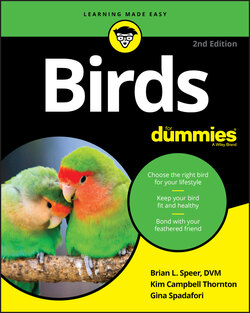Читать книгу Birds For Dummies - Gina Spadafori - Страница 65
WILD-CAUGHT VERSUS CAPTIVE-RAISED BIRDS
ОглавлениеThe Wild Bird Conservation Act of 1992 changed the pet bird landscape dramatically in the United States, virtually eliminating the flow of wild-caught birds into the country for the pet trade. Similar acts have been implemented in many countries as well, helping to keep wild birds where they belong — in their wild habitats — and domestically reared birds with humans. The bill was a huge victory for animal activists who documented problems in the import trade, where birds, at times, died before ever coming close to a caring home and their habitats, nesting sites, and family structures were damaged or destroyed during their capture.
This shift toward captive breeding of pet birds has provided an unintended benefit: improved availability of better pet birds, from both a health and a temperament perspective. Caring, informed aviculturists (people who raise and care for birds) stepped up to the challenge to produce companion birds who are well raised, see humans as friends, and aren’t damaged by the stresses of being captured and removed from their natural environments.
The reduction in the demand for wild-caught birds for the pet bird trade hasn’t ended threats to the survival of parrot species in the wild. Habitat destruction is proving to be just as damaging, if not more so, to many bird species. Organizations such as the World Parrot Trust (www.parrots.org) are fighting to preserve birds in the wild. We encourage you to support them.
Review Chapter 2 for our evaluation of each of the popular pet bird species — and some of the more unusual ones, too. If you’re just starting out, you may want to explore Chapter 19, which features our picks of the ten best birds for beginners. And no matter whether this is your first bird or you’re an experienced bird keeper, check out Chapter 17 for a quick rundown of the right questions to ask when you buy a bird.
